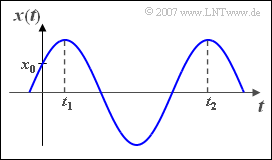Difference between revisions of "Aufgaben:Exercise 2.3Z: Oscillation Parameters"
From LNTwww
(Die Seite wurde neu angelegt: „ {{quiz-Header|Buchseite=Signaldarstellung/Harmonische Schwingung }} right| Jede harmonische Schwingung kann auch in der Form…“) |
|||
| Line 3: | Line 3: | ||
}} | }} | ||
| − | [[File:P_ID316__Sig_Z_2_3.png|right|]] | + | [[File:P_ID316__Sig_Z_2_3.png|right|Schwingung mit eingezeichneten Parametern]] |
Jede harmonische Schwingung kann auch in der Form | Jede harmonische Schwingung kann auch in der Form | ||
:$$x(t)=C\cdot\cos\bigg(2\pi \cdot \frac{t-\tau}{T_0}\bigg)$$ | :$$x(t)=C\cdot\cos\bigg(2\pi \cdot \frac{t-\tau}{T_0}\bigg)$$ | ||
| Line 18: | Line 18: | ||
Von einer harmonischen Schwingung ist nun bekannt, dass | Von einer harmonischen Schwingung ist nun bekannt, dass | ||
| − | :* das erste Signalmaximum bei $t_1 = 2 \text{ms}$ auftritt, | + | :* das erste Signalmaximum bei $t_1 = 2 \,\text{ms}$ auftritt, |
| − | :* das zweite Signalmaximum bei $t_2 = 14 \text{ms}$ auftritt, | + | :* das zweite Signalmaximum bei $t_2 = 14 \,\text{ms}$ auftritt, |
| − | :* der Wert $x_0 = \text{x(t = 0)} = 3 \text{V}$ ist. | + | :* der Wert $x_0 = \text{x(t = 0)} = 3 \,\text{V}$ ist. |
| + | |||
| + | ''Hinweise:'' | ||
| + | *Die Aufgabe gehört zum Kapitel [[Signaldarstellung/Harmonische_Schwingung|Harmonische Schwingung]]. | ||
| + | *Sollte die Eingabe des Zahlenwertes „0” erforderlich sein, so geben Sie bitte „0.” ein. | ||
| − | |||
| Line 30: | Line 33: | ||
<quiz display=simple> | <quiz display=simple> | ||
| − | {Wie groß ist die Periodendauer | + | {Wie groß ist die Periodendauer $T_0$ und die Grundfrequenz $f_0$? |
|type="{}"} | |type="{}"} | ||
| − | $T_0$ = { 12 3% } $\text{ms}$ | + | $T_0$ = { 12 3% } $\text{ms}$ |
| − | $f_0$ = { 83.33 3% } $\text{Hz}$ | + | $f_0$ = { 83.33 3% } $\text{Hz}$ |
{Welchen Wert haben hier die Verschiebung $\tau$ und die Phase $\varphi$ (in $\text{Grad}$)? | {Welchen Wert haben hier die Verschiebung $\tau$ und die Phase $\varphi$ (in $\text{Grad}$)? | ||
|type="{}"} | |type="{}"} | ||
| − | $\tau$ = { 2 3% } $\text{ms}$ | + | $\tau$ = { 2 3% } $\text{ms}$ |
| − | $\varphi$ = { 160 3% } $\text{Grad}$ | + | $\varphi$ = { 160 3% } $\text{Grad}$ |
{Wie groß ist die Amplitude der harmonischen Schwingung? | {Wie groß ist die Amplitude der harmonischen Schwingung? | ||
|type="{}"} | |type="{}"} | ||
| − | $ | + | ${C}$ = { 6 3% } $\text{V}$ |
| − | {Wie lautet das Spektrum? Welches Gewicht hat die Spektrallinie bei $+f_0$? | + | {Wie lautet das Spektrum $X(f)$? Welches Gewicht hat die Spektrallinie bei $+f_0$? |
|type="{}"} | |type="{}"} | ||
$\text{Re}[X(f = f_0)]$ = { 1.5 3% } $\text{V}$ | $\text{Re}[X(f = f_0)]$ = { 1.5 3% } $\text{V}$ | ||
Revision as of 15:17, 15 January 2017
Jede harmonische Schwingung kann auch in der Form
- $$x(t)=C\cdot\cos\bigg(2\pi \cdot \frac{t-\tau}{T_0}\bigg)$$
geschrieben werden. Die Schwingung ist somit durch drei Parameter vollständig bestimmt:
- die Amplitude $C$,
- die Periodendauer $T_0$,
- die Verschiebung $\tau$ gegenüber einem Cosinussignal.
Eine zweite Darstellungsform lautet mit der Grundfrequenz $f_0$ und der Phase $\varphi$:
- $$x(t)=C \cdot\cos(2\pi f_0t-\varphi).$$
Von einer harmonischen Schwingung ist nun bekannt, dass
- das erste Signalmaximum bei $t_1 = 2 \,\text{ms}$ auftritt,
- das zweite Signalmaximum bei $t_2 = 14 \,\text{ms}$ auftritt,
- der Wert $x_0 = \text{x(t = 0)} = 3 \,\text{V}$ ist.
Hinweise:
- Die Aufgabe gehört zum Kapitel Harmonische Schwingung.
- Sollte die Eingabe des Zahlenwertes „0” erforderlich sein, so geben Sie bitte „0.” ein.
Fragebogen
Musterlösung
1. Es gilt $T_0 = t_2 – t_1 = 12 \text{ms}$ und $f_0 = 1/T_0 \underline{\approx 83.33 \text{Hz}}$.
2. Die Verschiebung beträgt $\tau = 2 \text{ms}$; die Phase ist $\varphi = 2\pi \cdot \tau/T_0 = \pi/3$ entsprechend $60°$.
3. Aus dem Wert zum Zeitpunkt $t = 0$ folgt für die Amplitude $\text{C} = 6 \text{V}$:
- $$x_0=x(t=0)=C\cdot\cos(-60\,^\circ)=\frac{C}{2}=\rm 3\,V \hspace{0.3 cm} \Rightarrow \hspace{0.3 cm}\hspace{0.15cm}\underline{\it C=\rm 6\,V}.$$
4. Die dazugehörige Spektralfunktion lautet:
- $$X(f)=\frac{C}{2}\cdot{\rm e}^{-{\rm j}\varphi}\cdot\delta(f-f_0)+\frac{C}{2}\cdot{\rm e}^{{\rm j}\varphi}\cdot\delta(f+f_0).$$
Das Gewicht der Diraclinie bei $f = f_0$ (erster Term) ist $\text{C}/2 \cdot e^{–\text{j}\varphi} \approx \underline{1.5 \text{V} – \text{j} \cdot 2.6 \text{V}}$.
